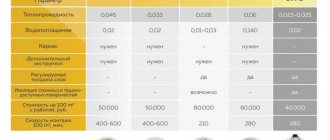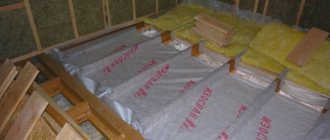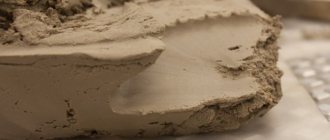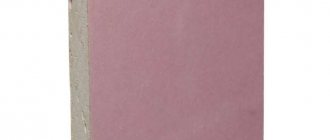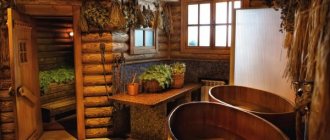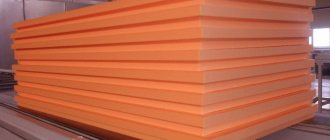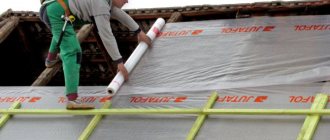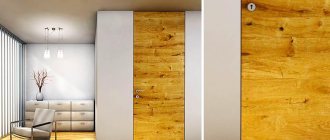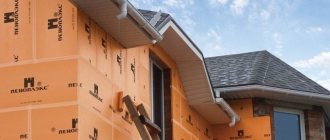A distinctive feature of mineral insulation is its structure consisting of fibers, which must be solid to ensure thermal insulation. In this regard, special attention should be paid to the cutting process. Do not use cardboard or fabric scissors, or ordinary table knives to cut the material. These tools are not intended for such material, as they can spoil its appearance and impair its useful properties. It is very useful for novice repairmen and builders to find out what tools are suitable for this task.
Characteristics and properties of the material
Mineral wool is produced in the form of slabs and rolls.
Before starting construction or repair work, the owner of the premises thinks about what criteria should be used to select materials. Currently, the sales range is replete with a variety of canvases that differ from each other in raw materials, price, scope of application, and operating characteristics.
The term “mineral wool” implies three types of materials, namely:
- basalt (stone);
- slag;
- glass wool
Glass wool (made from fiberglass) is characterized by low density and high hygroscopicity. The material does not have moisture resistance properties, and heat resistance should not be expected from it: when a high heating temperature is reached (about 300 degrees), the wool fibers melt, and the material no longer serves as an insulator. Glass wool is sold in rolls.
Glass wool is produced using the blow molding method: an industrial centrifuge creates air flows that go directly into the raw material. Due to the flow of air, fibers appear from the threads, and they can have different lengths, directions and thicknesses.
Mineral wool has low thermal conductivity, allows steam to pass through due to the cells in its structure, and almost does not absorb water. In addition to the base, there are few binding elements in the composition, which allows it to withstand high temperatures. The material is widely used as sound insulation and insulation for various substrates and surfaces. It is produced in sheets that vary in strength.
Slag wool for room insulation
Slag wool is the cheapest option for insulation. The material consists of fibers that are waste from blast furnaces; it is not dense and does not have good heat resistance. If you overheat slag wool, it will sinter. Therefore, the material is not suitable for insulating rooms adjacent to heat sources, and is also not recommended for building houses.
The structure of the horizontal layer of any type of mineral wool is created in the direction of the fiber. The formation of vertical sections occurs due to elements that are located chaotically. Each type of material has its own characteristics and external differences.
Thermal insulation of the floor
Interfloor and attic floors are made of load-bearing beams or reinforced concrete. In the first case, the heat insulator is placed in the space between the floor beams, and in the second - on the surface of the slabs.
Insulation of the attic floor
First of all, it is necessary to install a vapor barrier. It will protect the thermal insulation from moisture and steam. Before laying the vapor barrier film, you must study the instructions for its use. If the vapor barrier is installed incorrectly, it will not perform its tasks.
Flat roofs are usually insulated with rigid mineral wool slabs, the density of which is more than 150 kg/m3. A layer of waterproofing is laid on top of it. The slabs must be laid very tightly to each other. In this case, the seams should not be located on the same line. The optimal thickness of the mineral wool layer is 25 centimeters.
You can also insulate interfloor and attic floors using sawdust. They are used together with sand, clay, lime and cement. The composition provides good thermal insulation.
Expanded clay is also often used to insulate the attic. This material contains a large number of pores, due to which the thermal insulation function is ensured.
When using these materials, financial costs will be lower, and the quality of thermal insulation will be no worse than in the case of mineral wool insulation. When choosing insulation, you should take into account the height and area of the building, the materials from which it is built and other parameters.
Are there any nuances in transportation and storage?
Manufacturers recommend storing mineral wool in intact packaging, and it is better if the pack is placed on a flat surface. Each stack of packages should not be higher than 2 meters. Optimal storage conditions are closed rooms that are resistant to moisture. It is not recommended to store insulation outside, but if this happens, then you need to cover it with a tarpaulin or film.
Cotton wool should only be stored horizontally
When transporting, you should follow the same rules: transport the cotton wool horizontally and in a dry truck bed. It is also necessary to provide the material with protection from mechanical influences and precipitation. When loading and unloading material, do not compress it too much.
Unpacking mineral insulation also requires certain nuances. The material should be removed from the packaging only before starting work, which will minimize various risks associated with damage to the insulation. When laying out the material for cutting, use its packaging as a bedding. Thus, the product will not get dirty. Also, the packaging can be used to collect other waste at a construction site.
Sawdust as insulation for the home
Sawdust is wood processing waste in the form of small shavings and wood dust. This well-known material has been used as insulation for a very long time, since it retains heat well, releases wood resins and is an excellent leavening agent.
Application area
The beginning of the history of using sawdust in low-rise construction goes back to those distant times, when they began to be added to clay and used to build floors from this mixture in village houses.
Such floors can be called ideal: they served for a very long time, were not damaged in any way, had no disadvantages and had very significant advantages - low cost and high thermal insulation.
Taking this ancient technology as a basis, modern industry began to produce the same high-quality building materials - granules, wood concrete, concrete with sawdust, wooden blocks.
Sawdust also continues to be used in low-rise construction. Private developers are especially interested in this material, who insulate walls, floors, ceilings with sawdust, and also use them for other purposes as needed.
What types of mineral wool are there?
Mineral wool is usually classified according to the material from which it is made. This leads to the conclusion that mineral wool, made from different starting materials, differs in structure - fibers, and, accordingly, in the type of cutting. So there are the following types of mineral wool:
- Glass mineral wool. Consists of glass melts.
- Stone mineral wool. It is most often made from various rock melts.
- Slag mineral wool. The starting material is blast furnace slag.
In fact, you should pay attention to the fact that sometimes mineral wool can be harmful. This is due to the fact that it contains dust and phenol-formaldehyde resins. Therefore, it is necessary to treat this material selectively, although mineral wool cannot be classified as a human carcinogen.
Soundproofing of interior partitions
We use Technoacoustic slabs 50 mm thick with double-sided plasterboard sheathing on a metal or wooden frame.
- We install the wall frame (wooden beams or metal profile) with a distance between the beams inside of 580-590 mm.
- On one side we cover the wall with OSB sheets, fiberboard or plasterboard.
- We lay stone wool.
- We lay the second layer of insulation with a seam spacing of 150 mm.
- We cover the insulation with sheets for finishing. We fix the sheets to the frame.
Attic insulation
Roof insulation between rafters is the most common method of thermal insulation. It can be done outside or inside.
- We lay the roof covering.
- We ensure good ventilation of the structure due to a 50-80mm wide ventilation gap separating the insulation from the final roofing covering. It is also necessary to install ventilation holes on the eaves, overhangs, ridges, and ridges and protect them from sliding snow.
- We prepare the hydro-windproof outer layer of the system by laying hydrofilm on top of the rafters.
- We lay insulation (for us it is TECHNONICOL Rocklight) in the space between the rafters. We make sure that the width of the insulation is 10-15% greater than the distance between the rafter legs. For example, if the width of the insulating board is 600 mm, then the distance between the rafters should be 580-590 mm.
- We sew an additional sheathing of timber with a cross section of 50*50 mm across the rafters.
- We lay the second layer of insulation with the joints spaced at least half their length.
- We cover the insulation with a vapor barrier film. We roll it out horizontally and fasten it with a construction stapler.
- We fasten the film sheets with acrylic tape for tightness.
- We lay the bases for finishing (leveling bars, OSB sheets, plywood, drywall).
Still have questions? Ask them to us in the comments.
Watch detailed video instructions on our YouTube channel:
What will we cut with?
This can be done with different devices, depending on the thickness of the mineral wool.
Thin materials (no more than 50 mm):
- kitchen bread knife with serrated edge;
- assembly construction knife;
- stationery knife.
Denser and thicker materials:
- special knives about 300 mm long. They are often offered by manufacturers of insulating materials. Such a tool has teeth of different sizes for cutting mineral wool of different thicknesses and densities;
- saws with straight teeth;
- hacksaw for metal;
- cutting machines. Used when cutting elements of complex shapes. However, for independent construction of your own house, that is, for one-time use, it is not advisable to purchase such expensive equipment - you will have to adapt to the capabilities of other tools.
External wall insulation technology
Insulating the façade with cotton wool is done using glue and special dowels with a large head. The material is supplied in the form of rolls or slabs, which are cut into pieces of the required size. You will also need a metal profile or wooden blocks between which the insulation will be fixed. You can cut the material with an ordinary sharpened knife. However, if the density is high enough (80-100 kg/cubic m), then you will have to cut it using a hacksaw. Insulation of the facade is carried out in the following order:
- a vapor barrier film is attached to the wall; it must release moisture under the mineral wool slabs and prevent cold air from entering the house;
- Then wooden blocks or a metal profile are attached to the wall in a vertical position. Their width should correspond to the thickness of the insulation. The interval between the posts should be such that the mineral wool is inserted with little effort;
- The insulation is fastened with glue and special dowels if the wall is stone, or with nails (screws) with large washers if the surface is wooden. For 1 sq. m you need 5-6 pieces;
- It is recommended to lay a windproof membrane on the fixed basalt wool, the joints of which are taped with adhesive tape;
- To ensure ventilation under the subsequent decorative coating, it is advisable to make a counter-lattice over the slabs from wooden blocks or a metal profile 10-15 mm high.
This technology is suitable when facade insulation under siding is required. However, in some cases, for example, in multi-story buildings, it is necessary to secure the insulation more firmly. In this case, it is additionally fixed to the surface with glue, and reinforcement is carried out at the same time. This operation strengthens the structure and dampens the thermal expansion of the material, which can contribute to the formation of cracks and increase thermal conductivity.
Reinforcement is made on the already installed insulation using special glue and mesh that is resistant to alkali. First, glue is applied on which the mesh is laid, then it is covered with another layer of adhesive. The final decorative finishing can be done using facade paint and decorative plaster.
Tools for cutting materials
A knife for cutting thermal insulation can be one of several types. The list of most commonly used tools includes hacksaws for metal or wood, as well as special knives, for example, a thermal knife for standard polystyrene foam.
Assembly knife
A mounting knife for cutting polystyrene foam and other materials is considered one of the most complex tools. With its help you can cut polystyrene foam, mineral wool, penoplex and any other insulation materials. It must be taken into account that when working with polystyrene foam, it can leave cracks, chips and other defects.
Hacksaw for wood or metal
A hacksaw is convenient for cutting wide slabs of mineral wool.
You can also cut foam or polystyrene with a simple hacksaw, which should have fine teeth and sharpening. Only such a tool will be able to easily separate the material without damage.
Kitchen bread knife
If it is not possible to purchase a professional knife for cutting insulation, you can use a standard kitchen version that is used to cut bread. It must be taken into account that it must be sharpened well.
Specialized knives
The length of the knife blade must exceed the width of the plate
Professional grade tools, such as electric ones, are capable of cutting any material. During their operation, you should follow the instructions and safety rules, and also take into account the type of insulation.
Knife for cutting insulation
The blade for standard glass wool and other materials should be selected based on the type of blade. The most popular are tools with blades made of carbon or stainless steel.
A knife with a stainless steel blade is used to work with mineral wool of any level. Its blade is equipped with large and small teeth; due to the comfortable blade, it fits well inside the slab and makes it possible to make even shaped cuts thanks to the sharp tip.
With a carbon steel blade, the tool is of the highest quality and can be sharpened without much effort. Such a knife must be carefully looked after, since it can become rusty - wipe it well and apply a special product after use.
Knife with stainless steel blade
A knife for cutting insulation with a long blade made of durable stainless steel is suitable for working with mineral wool of any thickness . To cut insulation of different hardness, larger and smaller teeth are located on each side. This blade easily penetrates the thickness of the slab, allowing you to make even shaped cuts thanks to its sharp tip.
Knife with carbon steel blade
The mineral wool cutting knife with a carbon steel blade has high cutting quality and is easy to sharpen . However, it requires more careful care compared to a stainless steel blade, as it is susceptible to rust. It must be wiped dry after each use and lubricated.
Briefly about the main thing
There are many options for cutting stone wool, from a regular stationery and kitchen knife to a professional cordless hacksaw and machine tools. The main criterion for their selection is a sharp blade, the length of which must exceed the thickness of the insulation. But if the amount of work to be done is large, it is better to purchase a special tool designed specifically for cutting fibrous materials. And don’t forget your own safety by using protective equipment.
Ratings 0
How to cut
When cutting mineral wool, it is important to maintain the shape and density of the material, avoid injury and avoid making too expensive purchases. Therefore, it is important to follow these tips:
- during self-construction, when the workers do not have sufficient experience, it is advisable to consult with specialists before starting cutting, especially if the presence of pieces of complex shapes is expected. This will help prevent unnecessary consumption of insulation;
- the cutting tool must be well sharpened so that the mineral wool does not tear into fibers and generates less dust;
- when cutting insulation, it should be taken into account that in order to ensure a tight covering of the insulated space with mineral wool, it is necessary to leave allowances of about 2 cm;
- It is better to cut rolled mineral wool before unrolling it;
- mineral wool slabs must be removed from the packaging and cut one at a time;
- It is not recommended to cut mineral wool “for future use” - for the entire volume of work at once. This increases the risk of accidental damage to its shape when additional shifting from place to place or stacking pieces on top of each other.
Terms of use
Before starting work, it is imperative to read the instructions for using the knife and ensure the safety of the installation in order to prevent both gross and minor mistakes and harm to your health. There are several basic rules.
The insulation should be cut at low ambient temperatures - in order to safely start cutting mineral wool, you will have to dress in a special durable suit that will prevent skin contact with toxic material and irritation.
To protect your hands from getting cuts and abrasions when cutting carelessly, you need to cover them with rubber or silicone-coated gloves.
The respiratory organs must be covered with a durable respirator, and the eyes must be protected with special professional glasses , since glass particles of foam or mineral wool can enter the respiratory tract or the mucous membrane of the eyes.
During installation work, it is necessary to take short breaks and open windows to ventilate the room. If possible, it is better to immediately work in a room with good ventilation.
To ensure that the heat-insulating material does not break and fewer particles fly off from it, the cutting tool must be technically sound and well sharpened. To reduce the amount of dust in the air, the insulation should be cut along the fibers.
During the cutting process, you need to count on the remainder of a small layer about 2 cm long in order to ensure a tight overlap of the insulated space.
Mineral wool lends itself better to cutting before unrolling.
Mineral wool panels should be removed from the packaging box and cut one at a time, so as not to accidentally damage its shape when transferring the material from one place to another and when placing them on top of each other.
Already cut pieces of insulation cannot simply be thrown onto the floor or onto another piece, since a huge amount of foam fibers will immediately begin to rise into the air. The material should be handled with extreme care.
In addition, when carrying out installation work yourself, the best option would be to consult with specialists, since you may have to cut pieces of complex shapes. Recommendations from a professional will help you avoid unnecessary waste of material. Manufacturers also advise starting to cut the wool before unrolling the roll, and to ensure smooth and accurate cuts, you need to mark the material on a ruler in advance.
The remaining thermal insulation material does not have to be thrown away. They will remain suitable for insulating pantries, garages, sheds or other utility rooms. In addition, they can be recycled and sold at a low price for later use.
Upon completion of work, it is recommended to thoroughly wash your face and hands with soap and cool water.
For more information about knives for cutting insulation, see the video below.
How to cut mineral wool correctly
Stone wool is often used to insulate houses - after all, it is not afraid of fire, is easy to install, and is inexpensive.
And one of its popular types is basalt insulation, the technical characteristics and properties of which depend on where it is specifically used.
By the way, we note that this material is one of the cleanest in terms of ecology.
Since this insulation is one of the types of mineral wool, it has several names, including basalt or stone wool.
Moreover, it not only surpasses all other types of mineral wool in terms of strength characteristics, but is also absolutely safe for humans and nature.
Compared to mineral wool made from metallurgical slag, basalt insulation is more environmentally friendly, easier to cut and install, and lasts longer.
Molten gabbro-basalt rocks, forming thin fibers, form the basis of basalt wool. By and large, this is fiberglass, but not from quartz, but from basalt. And this material was invented (or rather, noticed) by the Hawaiians.
Once, when one of the volcanoes once again erupted lava and cooled down, local residents found amazing fibers, long and strong, in the remains of the lava.
Later, what was done by nature, people were able to repeat it, inventing the production of basalt fibers.
The volcanic rock is basalt.
To do this, the rock must be crushed and melted. The temperature in the melting furnace is very high - 1500 degrees, no less. Then the melt enters special drums, where it rotates, blown by an air stream.
Then the cotton wool is heated to 300 degrees, passing through a press 2 times.
The fibers in basalt insulation do not have a strict orientation, but are located very chaotically, so the structure of the substance is airy. Countless layers of air between thin stone fibers are an excellent heat insulator.
Therefore, the thermal conductivity coefficient of this material is very small - its value ranges from 0.032 to 0.048 watts per meter per Kelvin.
This corresponds to the level of cork, foam rubber and expanded polystyrene, both extruded and ordinary.
Let's try to compare the technical characteristics of basalt thermal insulation and other materials. Let's take, for example, a 10 cm mat made of basalt insulation, the density of which is 100 kilograms per cubic meter.
In order for the heat preservation effect to be similar, you need to build a ceramic brick wall 117 centimeters thick. If the brick is made of clay, then the wall should be even thicker - 160 centimeters.
A two-meter wall will have to be laid out of sand-lime brick, and the layer of wood must be at least 25.5 centimeters.
This material has the property of hydrophobicity. Water falling on it cannot penetrate inside, due to which the thermal insulation properties do not change. But if you conduct a similar experiment with ordinary mineral wool, it will absorb a fair amount of water.
Wet cotton wool will not retain heat - after all, water entering its pores significantly increases the thermal conductivity of the material. So if you need to insulate a damp room, for example, a sauna, then take basalt wool rather than ordinary glass wool - you can’t go wrong.
Water absorption by volume is no more than 2%.
Water does not impregnate, but flows around the fibers of basalt wool, since during the production process it is impregnated with special oils.
Basalt fiber, regardless of its density, has excellent vapor permeability. The moisture contained in the air easily penetrates the insulation layer without forming condensation inside it.
This is especially important for a bath or sauna. The basalt wool itself does not get wet, still reliably storing heat. Therefore, living in rooms insulated with this material is comfortable - the temperature and humidity conditions are optimal.
Vapor permeability is about 0.3 mg/(m h Pa)
In accordance with the requirements set by firefighters, wool made from basalt fibers is considered a non-flammable substance. But that's not all - it can block the path of open fire.
The maximum temperature that basalt insulation can withstand without reaching the melting point is 1114 0C. This allows it to be used for insulating devices operating at high temperatures.
If we consider the fire safety performance of this heat insulator (determined according to NPB 244-97), then stone wool is classified as a non-combustible material (NG group).
We suggest you familiarize yourself with: Foil insulation for baths and saunas
Any buildings, structures, structures and structural elements can be insulated with this material.
As for the acoustic properties, basalt wool also has good ones - in the sense of sound insulation, of course. This insulation is capable of muffling vertical sound waves traveling inside the walls.
Thanks to this, the room is well isolated from external noise.
By absorbing sound waves, stone wool reduces the reverberation time, which protects from noise not only the room whose walls are insulated with this material, but also neighboring rooms.
Operational features of basalt wool
Mineral wool has the following advantages:
- wide range of products. Mineral wool is produced in the form of slabs, rolls or mats. Due to this, it is possible to choose the option that is best suited for thermal insulation of a certain area of the building. Also, types of mineral wool differ in density: material in the form of slabs has a high density, and roll insulation is lighter;
- has high thermal insulation characteristics. Mineral wool has a porous structure. This material consists of small layers. Due to this, it retains heat well and also provides excellent sound insulation;
- fire safety of the material. Mineral wool does not burn and does not spread fire. For this reason, it is often used for thermal insulation of interfloor ceilings. Manufacturers of mineral wool claim that this material can withstand temperatures above 900 degrees Celsius;
- mineral wool does not deform, and this is a very important advantage. This material does not shrink, therefore, there is no formation of “cold bridges” that cause heat loss;
- frost resistance. This property allows the use of mineral wool for thermal insulation of external elements of a building;
- mineral wool is an environmentally friendly material. It is used for thermal insulation of health resorts and medical institutions, as well as children's rooms.
This insulation is produced in various forms - plates, cylinders, mats; You can buy cotton wool covered with foil.
Mineral wool has features that cannot be called positive. These include:
- low strength. This is due to the high porosity of mineral wool;
- to ensure a high level of thermal insulation, this material should be used together with a waterproofing film and a vapor barrier membrane;
- when using mineral wool with fiberglass, it becomes unsafe because formaldehyde is added to it;
- high hygroscopicity (therefore high waterproofing is done).
To attach such insulation, planks are nailed to the inside of the rafters (they are used to make a lattice), to which the cotton wool will be attached. On the outside, cotton wool is laid in one layer (the layers depend on the thickness of the wool).
After laying the insulation, waterproofing is applied. It is important at this stage not to confuse the sides of the insulation. The top layer does not allow moisture to pass through, and the bottom layer is an obstacle to steam.
The waterproofing is not stretched; an air space remains between it and the wool. There should be air space in front of the skate, which will create additional traction.
Scheme of basalt insulation.
- thermal insulation and hydrophobization. The first parameter is from 0.042 to 0.048 W/mK. Other well-known insulation materials (for example, polystyrene foam, polyurethane foam) have approximately the same characteristics. Mineral wool is not able to accumulate moisture (hygroscopicity is less than 1%), which makes its weight unchanged. A distinctive feature is vapor permeability, which guarantees insulation and at the same time intense moisture exchange between the external environment and the walls of the building;
- density, strength. The insulation has sufficient density (from 30 to 100 kg/cubic m), which guarantees high thermal insulation properties with optimal strength. The rigidity of the material is ensured by the direction of the fibers; they are located in horizontal and vertical directions;
- soundproofing. Good noise protection characteristics are achieved due to the porous structure of the wool;
- resistance to aggressive environments. Vata is “indifferent” to alkali and acids; does not rot, is not affected by fungus. Rodents also avoid this insulation;
- fire resistance. Basalt wool can withstand heating up to 700°C. This protects the structure from complete destruction in a fire and gives time for residents to evacuate;
- health safety. In production, resins containing harmful substances (formaldehyde, phenol) are used. However, adherence to the technology requires their introduction into the insulation composition in a chemically bound state. The substances become completely neutral in relation to the environment and do not pose a danger to humans.
How to cut mineral wool in a roll
Mineral wool is an artificial building material that is made for heat and sound insulation of residential buildings and industrial premises. The material is not afraid of fire, resistant to various weather conditions. For convenience, they are produced in rolls and mats. It is not enough to purchase insulation; it is also important to know how to work with it; this will be discussed below.
Insulating the attic space is an effective way to reduce heat loss; as a result, the house needs to be heated less, which means you can save on electricity.
Mineral wool insulation is a versatile, high-performance option for thermal and acoustic performance, as well as fire resistance.
The insulation consists of fibers.
When working with material, a large number of harmful particles are released into the air. Fine dust is hazardous to human breathing and skin. Therefore, precautions are taken when working with it.
What rules must be followed:
- work in a well-ventilated area.
- For work, personal protective equipment is used: mask, goggles, respirator.
- They work in special clothing: well-buttoned overalls, a hat, and construction gloves.
- After work, wash your hands and face thoroughly under cold water. The overalls are shaken out of dust.
To insulate a house with mineral wool, it is cut and the material is cut lengthwise and crosswise. Each type of cut has its own rules, following which the work will be much easier to do.
Mineral wool in rolls is cut unpacked. The roll is placed on a hard, flat surface. Use a tape measure to measure the required length. Place marks in three places around the package. For accuracy, the cutting area is wrapped with masking tape.
Then take a saw and cut a roll of mineral wool in a circle. After the cut piece has been separated, remove the packaging film.
Important. Masking tape is wound onto the roll on the opposite side of the workpiece so that after cutting the remaining part of the roll does not unwind.
For cross-cutting, the mineral wool roll is unpacked. Make markings on both sides. Then apply a flat bar: a ruler, a piece of profile or a beam.
A knife or hacksaw is used along the plank. If it is not possible to cut off the insulation in one movement, the cut is repeated several times. The material is cut to the end so that it does not have to be torn off, in which case the geometry will be disrupted. You'll have to level the insulation.
Important. When cutting the insulation, put a board under it so that the knife does not become dull.
In production, the material is cut on machines using special circular saws. At home, you can cut the insulation using a utility knife, a wood saw and special knives for insulation.
Tools:
- A stationery knife is used only for transverse cuts, since its blade size is not large. The cutting part quickly becomes dull, which is why the blade is often changed. A stationery knife is used to cut a small amount of insulation.
- To cut the mineral wool along the roll, use a wood saw. A hacksaw has a long blade that cuts through a roll. The disadvantage is that after such a cut there remains a lot of waste from the insulation. When carving, the teeth of the hacksaw tear out pieces of insulation.
- A bread knife with a long blade 200 - 300 mm is a convenient tool for cutting insulation along and across a roll. The serrated blade easily cuts insulation fibers without leaving much waste. The disadvantage of a kitchen knife is that it quickly becomes dull. If there is a lot of work, the knife will have to be sharpened periodically to ensure an even cut.
- Special knives are made for professional cutting of mineral wool. The length of the tool with handle is 500 mm, the length of the blade is 330 mm. The knives are made of stainless and cold-rolled steel; the special wavy-toothed sharpening of the tool allows for smooth cutting of the material.
Choosing the right tool for the job and following the recommendations will help make home insulation an enjoyable and useful task that will not bring unnecessary hassle.
Tips for cutting insulation
To prevent the material from tearing when cutting, creating a large amount of dust and waste, the tool must be sharp. Due to the nature of the insulation, consisting of stone or glass fibers, it quickly becomes dull and requires frequent sharpening. Or, in the case of a utility knife, replacing the blade.
Before cutting mineral wool in slabs, markings are applied to them, an even strip is pressed against it and the cut is made by pressing the tool blade against the guide and holding it vertically.
To cut rolled insulation, markings are made directly on the packaging, gluing masking tape around its circumference.
It is important! In order for the insulation to fit tightly to the side edges of the frame or rafters, its width should be 5-20 mm greater than the distance between them. Take this into account when marking.
Safe working conditions
When working with glass wool, you must wear protective clothing.
The main component of mineral wool is thin and sharp fibers. During operation, they break away from the base and rise into the air. Contact of these particles on the body causes burning of the skin, pain in the eyes and irritation of the respiratory mucosa.
To prevent harm to your own health, it is necessary to create the following working conditions:
- preventing accidental entry of strangers into the place of work;
- removing people and animals to a safe place if cutting is done outdoors;
- use of overalls, masks, respirators, sealed goggles and rubberized gloves;
- high-quality ventilation in the room, preventing the entry of volatile substances into neighboring rooms;
- cutting across the grain to reduce the amount of volatile compounds;
- wet cleaning with preliminary cleaning of surfaces with a vacuum cleaner;
- covering the insulation with plaster, vapor-permeable or windproof film for complete insulation.
After finishing cutting and installation, you need to take a shower, preferably under cool water, so that the fibers come off the skin and hair more easily.
Why do professionals choose ROCKWOOL stone wool?
Non-flammability
ROCKWOOL stone does not burn and also prevents the spread of fire, thereby providing more time to save people and property in the event of a fire. The fibers of the material can withstand temperatures up to 1000 °C, which protects structures from fire and thereby prevents their destruction. Stone wool does not emit heat, smoke or burning droplets in the event of a fire, guaranteeing safety and STIHL.
Non-flammability
ROCKWOOL insulation is highly resistant to fire. It helps localize the fire and prevents its spread. In addition, it does not emit toxic substances and is safe for insulating children's rooms.
Aesthetics
A harmonious combination of operational and aesthetic qualities.
When people live or work in a beautiful place, it increases their sense of comfort and increases their motivation. An environment where people enjoy their time helps strengthen social connections and makes the surrounding area safer and more welcoming.
Aesthetics
You don't have to limit the flight of your imagination when choosing the appearance of the facade of your home. The wide range of Rockpanel cladding slabs will allow you to design exactly the kind of façade system that is needed for the project.
You can create an easy-to-use, cost-effective and above all very attractive building cladding with Rockpanel's easy-to-work and versatile products, which are available in a wide range of colors and designs to suit your creativity.
With minimal waste, ease and speed of installation, our products are a smart choice from a financial point of view as well. In general, this is one of the most economical ways to reconstruct facades and cladding new buildings.
Today, a method has been developed for producing a special type of insulation - stone wool made from basalt. Twenty years ago, such mineral wool was used exclusively for the needs of the defense industry, but today this insulation is widely used for thermal insulation of any buildings.
Mineral wool does not contain components harmful to the environment such as acrylic and phenol-formaldehyde resins. It consists only of natural binders, therefore it is safe for humans. This thermal insulation material not only perfectly retains heat, but also allows you to create reliable sound insulation of rooms. Basalt mineral wool is becoming more and more popular and has already been tested by time, but people still have a lot of questions regarding technological issues, which we will try to focus on in this article.
How to properly attach mineral wool?
In this case, everything depends on the type of insulation and on the type of structure on which the thermal insulation is mounted. Lightweight grades of mineral wool are installed in frame structures by surprise. Rigid mineral wool boards are fastened with special dowels or fixed using special adhesives.
When fastening by surprise, mineral wool is placed very tightly into a wooden frame pre-assembled from slats and bars. The thickness of the frame must correspond to the thickness of the insulation. The interval between the slats is 1.5-2 cm less than the width of the mineral wool, which does not allow the material to slide during operation. The mats are installed starting from the bottom of the structure, and the rolls from the top. In this case, solid pieces are laid first, and free space, for example, near doors or windows, is filled later.
High-density mineral wool is often installed without intermediate/support beams. It is completely inserted behind the frame and pressed against the supporting structure without a gap, after which, for safety, it is fixed with dowels with a wide head, that is, the so-called “dish-shaped” dowels. In such a system, frame elements are placed on top of the insulating layer and press the wool against the wall; in addition, brackets that pass through the mats help to hold the insulation in place.
When using the method of bonded thermal insulation (wet method), frames are not used at all, so adhesives must be used as fastening. In this case, you will have to purchase a dry mixture, but it must be intended for gluing mineral wool insulation. Recently, polyurethane glue in cylinders has become increasingly popular, which allows you to mount dense mineral wool to any base, including wood, metal, and polymer. This technology also involves the use of disc dowels. We discussed in more detail the features of gluing insulation in articles on adhesive compositions and wet insulation of facades.
What is the best way to cut mineral wool?
It is recommended to cut thermal insulation materials from stone wool with a hacksaw or with a sharp long knife specially designed for this purpose, the blade of which is serrated. In any case, the equipment must be well sharpened so that as few fibers are pulled out as possible. Many companies that produce insulation also offer their customers cutting tools: knives about 300 mm long, as well as saws with straight teeth, about 60 cm long. In the absence of special devices for such purposes, kitchen bread knives with fine teeth work well and a wavy edge. Thin soft boards and mats (50 mm) can be cut with a regular mounting knife.
It is best to cut mineral wool produced in rolls before unrolling them. And mineral wool slabs are taken out of the packs and cut one at a time. It should be remembered that when installing thermal insulation, the insulation must fill the entire insulated space very tightly, so allowances should be left before cutting: for slabs - 0.5 cm; and for mats - about 1-2 cm.
Is it true that mineral wool needs to be protected from moisture and wind?
During the operation of insulated buildings, their walls, roofs and other structures should be protected from increased atmospheric humidity and from blowing by strong winds. Therefore, after installation, mineral wool insulation is covered from the outside with sheets of vapor-permeable, moisture- and windproof membrane. This allows you to prevent cold winds and drops of slanting rain from penetrating into the thickness of the wall. In this case, water vapor from the internal space, passing through the walls through diffusion, will be able to exit outside without obstacles.
The undoubted advantage of mineral wool is its vapor permeability, and this property should be used to the maximum. When installing mineral wool thermal insulation materials between the load-bearing wall and the insulation, there is no need to install a vapor barrier, since such sealing will negatively affect the climate inside the building. The lack of artificial ventilation in this case will lead to increased humidity and the formation of condensation, which, in turn, will cause the formation of mold and fungi.
A vapor barrier film must be used when installing thermal insulation indoors - in this case it is installed on the warm side of the mineral wool. This allows you to protect the insulation from water vapor from the premises. Reinforced polyethylene can be used as a vapor barrier, which is placed between the insulation and the cladding.
If the design allows, a ventilated air gap should be provided between the insulation and the exterior finish. This will help keep the mineral wool dry without reducing the vapor permeability of the building.
What to do if you need to use a 15 or 20 cm layer of wool, but the insulation is supplied 5 or 10 cm thick?
There is nothing complicated here. You need to calculate the required thickness using formulas or using an online calculator (we talked about this in the last article), and then you can easily create an insulating barrier from several layers. In addition, this method allows you to easily eliminate the problem of the formation of cold bridges and blowing of joints. To do this, when installing insulation, the sheets of the outer and inner layers should be shifted relative to each other by 20-30 mm in order to reliably cover the seams.
Is it necessary to use protective equipment? Which?
Mineral wool is considered a safe thermal insulation material, both during operation and during installation. However, when working with this insulation for a long time, it is still better to protect yourself by using personal protective equipment.
Stone wool, compared to glass wool, is much more convenient to use and safer, but you should still be careful when installing it. It is best to work on cool days in overalls made of thick fabric, covering the entire body from contact with mineral wool. It is not recommended to touch this material with bare hands; to protect them, you can use “glazier gloves” - fabric ones with rubber or silicone coating in the palm area. It is also imperative to protect your eyes and scalp. To protect the respiratory system, wear a respirator.
During the installation of stone wool, you should take a break to ventilate the room. Open packs of material must be moved carefully, preventing them from falling, so that microparticles do not escape from them. There should be no children or people not using protective equipment on the construction site during installation of thermal insulation.
Are there any nuances in transportation and storage?
Mineral wool insulation should be stored in whole packages on a flat, dry surface; the height of the stacks should not exceed 2 meters. Stacks are made in closed spaces protected from rain and humidity. If mineral wool is stored outdoors, it should be covered with plastic wrap or a tarpaulin.
Mats and insulation boards are transported horizontally in covered trucks. During transportation, the insulation must be protected from mechanical damage and precipitation. During loading/unloading and transportation, the material must not be compressed too much.
You need to unpack mineral wool correctly. To do this, remove the insulation from the packaging immediately before installation, which significantly reduces the risk of damage to the thermal insulation. Insulation packaging can be used on a construction site when laying out mineral wool (when you need to protect it from contamination); it is also suitable as bags for construction waste.
Which cotton wool is better?
There is no definite answer to this question, since in different conditions the best option will be different types of material.
Basalt soft wool. It is used where high loads are not expected. This material can be used for insulating walls made using frame technology, as well as for thermal insulation of floors and roofs. The fact that cotton wool is soft does not mean that its performance characteristics are poor. It is simply made from thin fibers, which ensures that the insulation contains many cavities in which air is retained, preventing heat loss.
Mineral wool of medium hardness (density). It is used mainly for insulating ventilated facades, where high-speed air flows are created in the air cavities. It is also used for fire prevention measures, sound and heat insulation of ventilation ducts. Medium-density mineral wool can be installed without problems instead of soft basalt wool, but the cost of thermal insulation will be more expensive.
Hard basalt wool. This insulation is used in places where high loads are possible. For example, where it is planned to insulate walls with reinforcement and plastering (wet method) or when creating certain types of floors.
Cylindrical insulation for pipes. They are usually produced with a diameter of more than 50 mm. They come in the form of slotted pieces that can be unrolled and slipped onto the pipe, or two-piece models that fit together on the pipe.
Foil basalt wool. This thermal insulation material is characterized not only by low heat transfer, but also reflects heat, directing it indoors. Mineral wool can be covered with foil on one or both sides. When laying, the heat insulator is installed with the foil side facing the heat source. The scope of application of this insulation is quite extensive; it is considered a universal material, suitable for all methods and types of thermal insulation.
Stitching cotton wool. It consists of very durable mats, one side of which is lined/reinforced with steel mesh (galvanized, stainless, fire-resistant, acid-resistant). The sheets can be of different thicknesses and can be used to perform various types of thermal insulation. Stitched wool is usually non-flammable, so it can be used to insulate surfaces with elevated temperatures (up to plus 660-700 degrees).
An important technical characteristic of mineral wool is its specific density. Insulation, the density of which is up to 75 kg per cubic meter, is ideal for thermal insulation of surfaces where heavy loads are not expected, for example, for installation in ceilings in attics and roofs. Low-density basalt wool is often used for wrapping pipes in heating plants, boilers and similar components/communications.
Stone wool, whose density is up to 125 kg per cubic meter, holds its shape well and is excellent for insulating ceilings, walls inside buildings, and various vertical structures. It is used for thermal insulation of brick walls, as well as surfaces made of foam block or aerated concrete. Mineral wool of this specific density allows not only to insulate a building, but also to ensure its reliable sound insulation.
High-density basalt wool - from 175 to 200 kg per cubic meter is also characterized by increased rigidity, hence the abbreviation in its name (PPZh). Such insulation is used for thermal insulation of initially too cold planes - reinforced concrete, sheet metal. The PPZH-200 brand is also excellent for providing additional protection for residential buildings against fire. Only high-density mineral wool can be installed using wet facade insulation technology.
